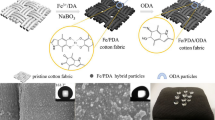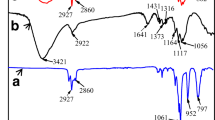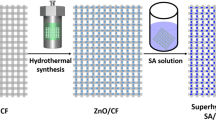Abstract
In this paper, a facile and efficient approach to robust and durable superhydrophobic cotton fabric was presented via in situ CuO deposition and stearic acid (STA) coating. The combined effects of both rough structure and low surface energy endowed cotton fabric (Cot) with superhydrophobicity, water repellency, and self-cleaning property. Moreover, the as-prepared fabric (Cot–CuO–STA) could keep its robust superhydrophobicity under harsh environmental conditions of acidic, alkaline and salt solutions, high temperature, mechanical abrasion and washing. Importantly, the obtained Cot–CuO–STA with WCA of 156.5° had great potential in oil/water separation with high separation efficiency of up to 98.7% for various oils (dichloromethane, trichloromethane, soybean oil, and n-heptane). Further, fascinating permeate flux (more than 1800 L.m−2.h−1) and remarkable recyclability made Cot–CuO–STA a promising application in oil-contaminated water treatment and marine spilt oil cleanup.
Graphic abstract
Robust and durable superhydrophobic cotton fabric was fabricated for oil/water separation via a facile and efficient route. The resultant fabric exhibited remarkable separation efficiency for different kinds of oils, fascinating permeate flux, and excellent recyclability.











Similar content being viewed by others
References
Cai J, Wang T, Hao W, Ling H, Hang T, Chung YW, Li M (2019) Fabrication of superamphiphobic Cu surfaces using hierarchical surface morphology and fluorocarbon attachment facilitated by plasma activation. Appl Surf Sci 464:140–145
Chen S, Li X, Li Y, Sun J (2015) Intumescent flame-retardant and self-healing superhydrophobic coatings on cotton fabric. ACS Nano 9(4):4070–4076
Chen Y, Meng J, Zhu Z, Zhang F, Wang L, Gu Z, Jiang L, Wang S (2018) Controlled growth of patterned conducting polymer microsuckers on superhydrophobic micropillar-structured templates. Adv Funct Mater 28:1800240
Cheng Y, Zhu T, Li S, Huang J, Mao J, Yang H, Gao S, Chen Z, Lai Y (2019) A novel strategy for fabricating robust superhydrophobic fabrics by environmentally-friendly enzyme etching. Chem Eng J 355:290–298
Dong XL, Gao SW, Huang JY, Li SH, Zhu TX, Cheng Y, Zhao Y, Chen Z, Lai YK (2019) A self-roughened and biodegradable superhydrophobic coating with UV shielding, solar induced self-healing and versatile oil-water separation ability. J Mater Chem A 7:2122–2128
El-Nahhal IM, Elmanama AA, Amara N, Qodih FS, Selmane M, Chehimi MM (2018) The efficacy of surfactants in stabilizing coating of nano-structured CuO particles onto the surface of cotton fibers and their antimicrobial activity. Mater Chem Phys 215:221–228
Ethiraj AS, Kang DJ (2012) Synthesis and characterization of CuO nanowires by a simple wet chemical method. Nanoscale Res Lett 7(1):70
Farhadi S, Farzaneh M, Kulinich SA (2011) Anti-icing performance of superhydrophobic surfaces. Appl Surf Sci 257(14):6264–6269
Fisher MC, Hawkins NJ, Sanglard D, Gurr SJ (2018) Worldwide emergence of resistance to antifungal drugs challenges human health and food security. Science 360:739–742
Foorginezhad S, Zerafat MM (2019) Fabrication of superhydrophobic coatings with self-cleaning properties on cotton fabric based on octa vinyl polyhedral oligomeric silsesquioxane/polydimethylsiloxane (OV-POSS/PDMS) nanocomposite. J Colloid Interface Sci 540:78–87
Gao SW, Dong XL, Huang JY, Li SH, Li YW, Chen Z, Lai YK (2018) Rational construction of highly transparent superhydrophobic coatings based on a non-particle, fluorine-free and water-rich system for versatile oil-water separation. Chem Eng J 333:621–629
Ge MZ, Cao CY, Liang FH, Liu R, Zhang Y, Zhang W, Zhu TX, Yi B, Tang YX, Lai YK (2020) A ‘‘PDMS-in-water’’ emulsion enables mechanochemically robust superhydrophobic surfaces with self-healing nature. Nanoscale Horiz 5:65–73
Gelebart AH, Mulder DJ, Varga M, Konya A, Vantomme G, Meijer EW, Selinger RLB, Broer DJ (2017) Making waves in a photoactive polymer film. Nature 546:632
Hou K, Zeng Y, Zhou C, Chen J, Wen X, Xu S, Cheng J, Pi P (2018) Facile generation of robust POSS-based superhydrophobic fabrics via thiol-ene click chemistry. Chem Eng J 332:150–159
Jia S, Chen H, Luo S, Qing Y, Deng S, Yan N, Wu Y (2018) One-step approach to prepare superhydrophobic wood with enhanced mechanical and chemical durability: driving of alkali. Appl Surf Sci 455:115–122
Kliche G, Popovic ZV (1990) Far-infrared spectroscopic investigations on CuO. Phys Rev B 42(16):10060
Kong L, Chen X, Yu L, Wu Z, Zhang P (2015) Superhydrophobic cuprous oxide nanostructures on phosphor-copper meshes and their oil–water separation and oil spill cleanup. ACS Appl Mater Inter 7(4):2616–2625
Li Q, Guo Z (2019) Lubricant-infused slippery surfaces: Facile fabrication, unique liquid repellence and antireflective properties. J Colloid Interface Sci 536:507–515
Lin D, Zeng X, Li H, Lai X, Wu T (2019) One-pot fabrication of superhydrophobic and flame-retardant coatings on cotton fabrics via sol-gel reaction. J Colloid Interface Sci 533:198–206
Liu G, Wang W, Yu D (2019a) Robust and self-healing superhydrophobic cotton fabric via UV induced click chemistry for oil/water separation. Cellulose 26(5):3529–3541
Liu R, Dai J, Ma L, Chen J, Shi X, Du Y, Li Z, Deng H (2019b) Low-temperature plasma treatment-assisted layer-by-layer self-assembly for the modification of nanofibrous mats. J Colloid Interface Sci 540:535–543
Liu Y, Fu K, Liu J, Tian Y, Zhang H, Wang R, Zhang B, Zhang H, Zhou F, Zhang Q (2019c) Design and preparation of a multi-fluorination organic superhydrophobic coating with high mechanical robustness and icing delay ability. Appl Surf Sci 497:143663
Liu Y, Moevius L, Xu X, Qian T, Yeomans JM, Wang Z (2014) Pancake bouncing on superhydrophobic surfaces. Nat Phys 10:515
Liu Z, Lin Z, Zhou L, Yang Z, Chen D, Zhang C (2018) High-performance planar perovskite solar cells using low temperature, solution–combustion-based ickel oxide hole transporting layer with efficiency exceeding 20%. Adv Energy Mater 8:1703432
Lu X, Wang C, Wei Y (2009) One-dimensional composite nanomaterials: synthesis by electrospinning and their applications. Small 5(21):2349–2370
Lvov Y, Wang W, Zhang L, Fakhrullin R (2016) Halloysite clay nanotubes for loading and sustained release of functional compounds. Adv Mater 28:1227–1250
Nanda D, Sahoo A, Kumar A, Bhushan B (2019) Facile approach to develop durable and reusable superhydrophobic/superoleophilic coatings for steel mesh surfaces. J Colloid Interface Sci 535:50–57
Peng C, Chen Z, Tiwari MK (2018) All-organic superhydrophobic coatings with mechanochemical robustness and liquid impalement resistance. Nat Mater 17:355
Perelshtein I, Applerot G, Perkas N, Wehrschuetz-Sigl E, Hasmann A, Guebitz G, Gedanken A (2009) CuO–cotton nanocomposite: formation, morphology, and antibacterial activity. Surf Coat Tech 204(1–2):54–57
Pokroy B, Kang S, Mahadevan L, Aizenberg J (2009) Self-organization of a mesoscale bristle into ordered, hierarchical helical assemblies. Science 323:237–240
Qing Y, Long C, An K, Hu C, Liu C (2019) Sandpaper as template for a robust superhydrophobic surface with self-cleaning and anti-snow/icing performances. J Colloid Interface Sci 548:224–232
Ren T, Yang M, Wang K, Zhang Y, He J (2018) CuO nanoparticles-containing highly transparent and superhydrophobic coatings with extremely low bacterial adhesion and excellent bactericidal property. ACS Appl Mater Inter 10(30):25717–25725
Rezaie AB, Montazer M, Rad MM (2018) Environmentally friendly low cost approach for nano copper oxide functionalization of cotton designed for antibacterial and photocatalytic applications. J Clean Prod 204:425–436
Riaz S, Ashraf M, Hussain T, Hussain MT, Younus A (2019) Fabrication of robust multifaceted textiles by application of functionalized TiO2 nanoparticles. Colloid Surface A 581:123799
Tang S, Zhang Y, Sana H, Hu J (2019) Hydrophobic surface contained Ca and/or Ce myristate fabricated on AZ31 by one-step electrodeposition for corrosion protection in NaCl. Appl Surf Sci 496:143627
Wang B, Liang W, Guo Z, Liu W (2015) Biomimetic super-lyophobic and super-lyophilic materials applied for oil/water separation: a new strategy beyond nature. Chem Soc Rev 44:336–361
Xue C, Fan Q, Guo X, An Q, Jia S (2019) Fabrication of superhydrophobic cotton fabrics by grafting of POSS-based polymers on fibers. Appl Surf Sci 465:241–248
Yan B, Zhou Q, Zhu X, Guo J, Mia MS, Yan X, Chen G, Xing T (2019) A superhydrophobic bionic coating on silk fabric with flame retardancy and UV shielding ability. Appl Surf Sci 483:929–939
Yang M, Liu W, Jiang C, Xie Y, Shi H, Zhang F, Wang Z (2019) Facile construction of robust superhydrophobic cotton textiles for effective UV protection, self-cleaning and oil-water separation. Colloid Surface A 570:172–181
Yang M, Liu W, Liang L, Jiang C, Liu C, Xie Y, Shi H, Zhang F, Pi K (2020) A mild strategy to construct superhydrophobic cotton with dual self-cleaning and oil–water separation abilities based on TiO2 and POSS via thiol-ene click reaction. Cellulose pp 1–11
Yang Y, Li X, Zheng X, Chen Z, Zhou Q, Chen Y (2018) 3D-printed biomimetic super-hydrophobic structure for microdroplet manipulation and oil/water separation. Adv Mater 309:1704912
Zhang J, Seeger S (2011) Polyester materials with superwetting silicone nanofilaments for oil/water separation and selective oil absorption. Adv Funct Mater 21:4699–4704
Zhang S, Liu H, Yang S, Yang S, Shi X, Zhang D, Shan C, Mi L, Liu C, Shen C, Guo Z (2019a) Ultrasensitive and highly compressible piezoresistive sensor based on polyurethane sponge coated with a cracked cellulose nanofibril/silver nanowire layer. ACS Appl Mater Inter 11:10922–10932
Zhang X, Liu Z, Li Y, Wang C, Zhu Y, Wang H, Wang J (2019b) Robust superhydrophobic epoxy composite coating prepared by dual interfacial enhancement. Chem Eng J 371:276–285
Zhao Y, Xing C, Zhang Z, Yu L (2017) Superhydrophobic polyaniline/polystyrene micro/nanostructures as anticorrosion coatings. React Funct Polym 119:95–104
Zhou C, Chen Z, Yang H, Hou K, Zeng X, Zheng Y, Cheng J (2017a) Nature-inspired strategy toward superhydrophobic fabrics for versatile oil/water separation. ACS Appl Mater Inter 9(10):9184–9194
Zhou H, Wang H, Niu H, Zhao Y, Xu Z, Lin T (2017b) A waterborne coating system for preparing robust, self-healing, superamphiphobic surfaces. Adv Funct Mater 27(14):1604261
Zhu Z, Liu Y, Hou H, Shi W, Qu F, Cui F, Wang W (2018) Dual-bioinspired design for constructing membranes with superhydrophobicity for direct contact membrane distillation. Environ Sci Technol 52:3027–3036
Acknowledgments
The work was financially supported by the Public Technology Research Plan of Zhejiang Province (LGF18E030003) and the Fundamental Research Funds of Zhejiang Sci-Tech University (2019Q008).
Author information
Authors and Affiliations
Corresponding author
Ethics declarations
Conflict of interest
The authors declare that they have no known competing financial interests or personal relationships that could have appeared to influence the work reported in this paper.
Additional information
Publisher's Note
Springer Nature remains neutral with regard to jurisdictional claims in published maps and institutional affiliations.
Electronic supplementary material
Below is the link to the electronic supplementary material.
Rights and permissions
About this article
Cite this article
Lu, R., Yu, Y., Adkhamjon, G. et al. Bio-inspired cotton fabric with superhydrophobicity for high-efficiency self-cleaning and oil/water separation. Cellulose 27, 7283–7296 (2020). https://doi.org/10.1007/s10570-020-03281-9
Received:
Accepted:
Published:
Issue Date:
DOI: https://doi.org/10.1007/s10570-020-03281-9




